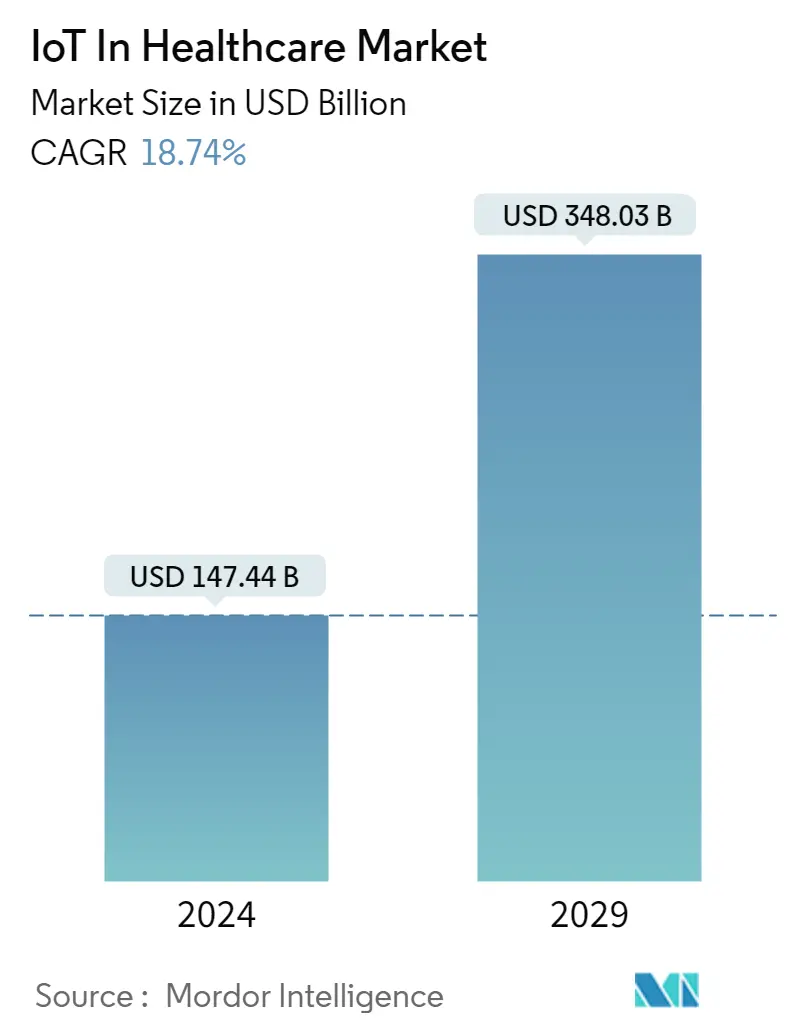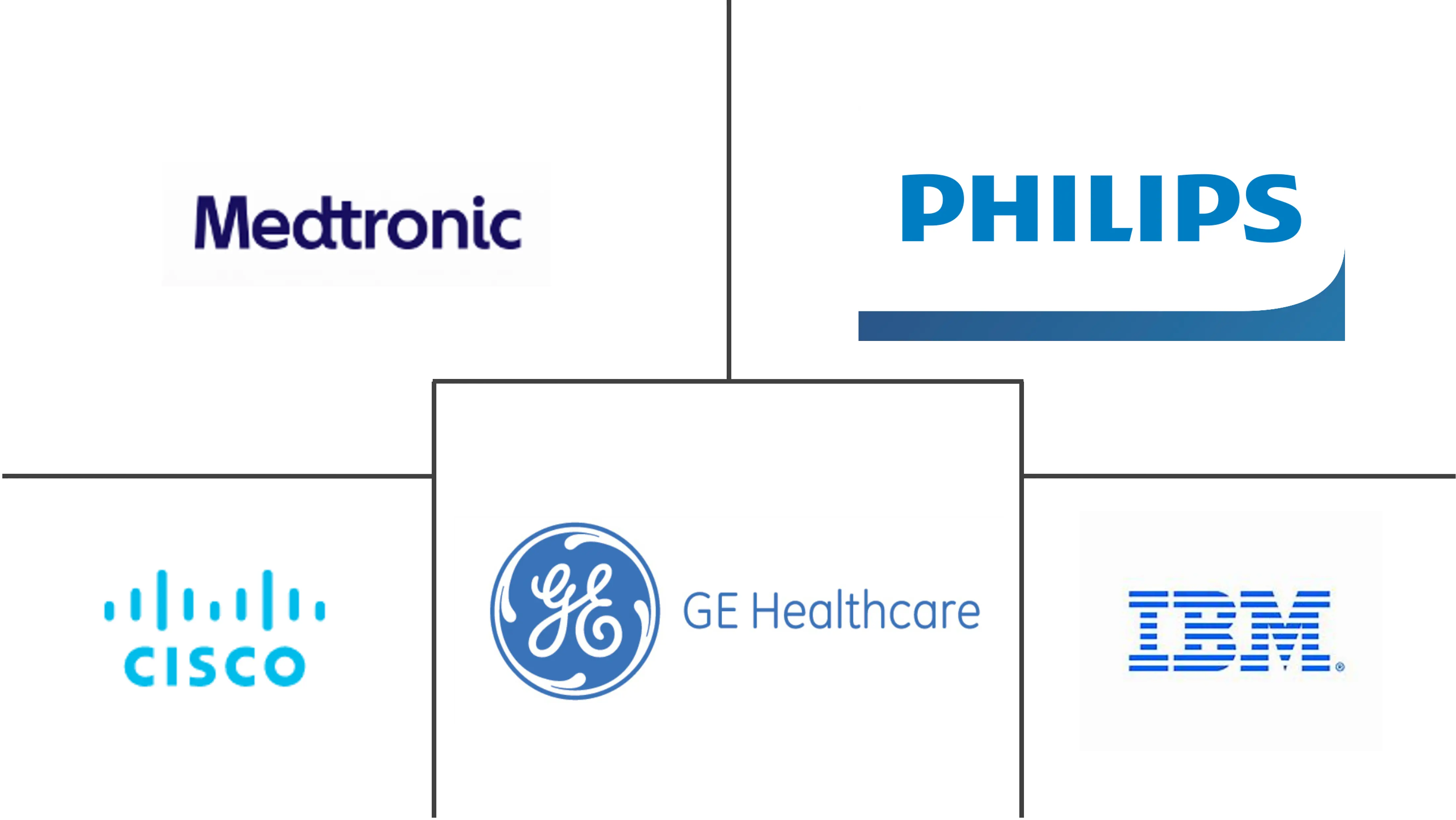Market Size of IoT In Healthcare Industry

| Study Period | 2019 - 2029 |
| Market Size (2024) | USD 147.44 Billion |
| Market Size (2029) | USD 348.03 Billion |
| CAGR (2024 - 2029) | 18.74 % |
| Fastest Growing Market | Asia Pacific |
| Largest Market | North America |
Major Players
*Disclaimer: Major Players sorted in no particular order |
Need a report that reflects how COVID-19 has impacted this market and its growth?
Internet of Things (IoT) in Healthcare Market Analysis
The IoT In Healthcare Market size is estimated at USD 147.44 billion in 2024, and is expected to reach USD 348.03 billion by 2029, growing at a CAGR of 18.74% during the forecast period (2024-2029).
The IoT market is driven by the growing adoption of healthcare information systems, the emergence of big data in healthcare, improved device accuracy and connectivity, and the increasing penetration of connected devices in healthcare.
- IoT technology has the potential to revolutionize traditional paper-based healthcare treatment by simplifying access to remote patient monitoring and real-time patient data. The emergence of this digital healthcare technology has addressed the impending need for better diagnostics and targeted therapeutic tools. In addition, it provides remote patient monitoring to physicians and works as a fitness and wellness tracker for athletes and a dosing reminder for patients. The successful implementation of IoT in the remote monitoring of asthma and diabetes patients, coupled with the high penetration of fitness and wellness devices, has created a high demand for the IoT healthcare market.
- Big data analytics is a fast-emerging topic in IoT. The demand for big data analytics integrates the most recent innovation in machine learning, logical methodologies, computational intelligence, and data mining. Many healthcare experts, including payers and providers, are now analyzing big data to obtain detailed knowledge. Even though these efforts are still in their early stages, they are expected to collectively help tackle the industry-related problems regarding inconsistency in healthcare quality and escalating healthcare expenditures. Organizations might leverage big data approaches and solutions to engage patients, personalize care, lower costs and variability, and enhance the quality of service.
- The market is driven by rising digital adoption in the healthcare industry. The healthcare sector has grown enormously due to technological advancements, digitization of healthcare, and government participation. Trends that have arisen throughout this stage have enabled modern technology to simplify further and enhance the patient experience. Nowadays, almost every element of healthcare uses technology like machine learning, automation, and artificial intelligence (AI). As a way to help doctors make more accurate diagnoses, AI and ML tools are becoming increasingly common.
- Artificial intelligence is a powerful tool that can increase the efficiency, speed, and effectiveness of the global health system. It has the potential to improve the efficiency of telemedicine. Researchers at UCLA have combined chatbot technology and an AI system to create a virtual interventional radiologist (VIR), which helps the patient self-diagnose or the doctor diagnose the patient.
- With the help of IoT, patients can convert their personal health information, such as the number of steps taken, vital signs, and calories burned, into non-personally identifiable information on the platform and store it safely, further supporting the data analysis and R&D activities of pharmaceutical companies and medical institutions to accelerate the development of medical devices and discovery of new drugs.
- Improvements in the quality of people's daily health and life activities, as well as big data analytics to support and promote such research activities, are some of the factors driving the market's growth, as IoT-based healthcare systems play a key role in the development of medical information systems. Tracking, tracing, and monitoring patients are essential to enhance the healthcare system.
- Market growth is projected to be restrained by difficulties such as the high costs of IoT infrastructure development, privacy and security concerns about data, a general lack of awareness among underdeveloped countries' populations, and a lack of technical expertise.
- The COVID-19 widespread distribution impacted businesses in many sectors, including healthcare. The pandemic created opportunities for IoT healthcare providers due to the increasing need for remote solutions for patient diagnosis and treatment, vaccine cold chain monitoring, and device unit management. The IoT in the healthcare sector is producing excellent results due to the disruption of fast Internet and network technologies. The lockdown's movement restrictions led to a rise in the usage of internet platforms for medical consultations. Medical experts could treat patients remotely using IoT-powered telemedicine solutions, thus boosting the growth of IoT in the healthcare sector.
